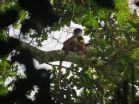(Press-News.org) Angiogenesis inhibitors--a widely used class of cancer drugs designed to shrink tumors by preventing them from forming new blood vessels--often work in the short term, but usually become ineffective within months. Now, a team led by UC San Francisco scientists has discovered a possible reason, one that could lead to a way to address the problem and prevent cancer relapse.
Working with laboratory models of pancreatic and breast cancer, the scientists found that myeloid cells, which originate in bone marrow and are part of the body's first-line of defense--the so-called "innate" immune system--at first work in concert with the therapy but then switch roles and undermine it.
As reported in the April 16, 2015 online issue of Cell Reports, the researchers, under the direction of senior investigator Gabriele Bergers, PhD, UCSF professor of neurological surgery, and first author Lee B. Rivera, PhD, a UCSF postdoctoral scholar in the Bergers laboratory, also identified a potential way to stop myeloid cells from sabotaging the therapy and prevent relapse. The key to the discovery, said Bergers, lies in the dual nature of myeloid cells, which exist in two basic states.
In one state, myeloid cells are immunity-enhancing and angiostatic - that is, they prevent the formation of new blood vessels. "This is important in the early stages of wound healing," she explained, "when they need to be immune-stimulatory and attack when bacteria, for example, are invading." But during the later stages of healing, "they need to switch to their other state, in which they are angiogenic"--generating new blood vessels--"and immune-suppressive, because new blood vessels need to form as part of tissue repair, and you don't want cells around that are in attack mode."
During anti-angiogenic therapy, said Bergers, the Neill H. and Linda S. Brownstein Endowed Chair in Brain Tumor Research and a member of the UCSF Helen Diller Family Comprehensive Cancer Center, "the tumor hijacks the second stage of the natural process we see in wound healing for its own advantage. But we have learned that we can also manipulate this process to make therapy more effective."
Angiogenesis inhibitors approved for clinical use, which include bevacizumab (Avastin), sunitinib (Sutent), and everolimus (Afinitor), work by blocking the vascular endothelial growth factor (VEGF) signaling pathway, which prevents the tumor from forming new blood vessels, thereby shrinking it.
The researchers found that during the initial phase of therapy, VEGF inhibition stimulates myeloid cells within the tumor to release the signaling protein CXCL14, which is angiostatic and stimulates immunity. During this phase, myeloid cells complement the therapy to prevent the creation of new blood vessels, and the tumor shrinks.
But then--probably in response to reduced oxygen flow within the tumor--myeloid cells switch to their opposite state "and become real bad guys," said Bergers. At this stage the cells activate the PI3-kinase (PI3K) signaling pathway, which neutralizes CXCL14 and promotes angiogenesis and tumor growth.
"Once the PI3K pathway is activated, therapy becomes ineffective, and you have relapse," she said.
In breast cancer, Bergers noted, anti-VEGF therapy is not very effective to begin with. "This tells us why," she said. "In a laboratory model of breast cancer, about 45 percent of myeloid cells are already activated, so the cancer just ignores the therapy."
The researchers found that targeting specific innate immune cells within the tumor did not reverse the negative effects of PI3K activation. Eliminating macrophages - one type of white blood cell - resulted in an increase in neutrophils, another type of white blood cell. But eliminating neutrophils brought on an increase in macrophages. This so-called myeloid-cell oscillation maintained the tumor's resistance to the therapy.
Instead, said Bergers, "we found that what you need to do is target the central signaling node, which is PI3K." Ultimately, the researchers demonstrated that combining a PI3K inhibitor with anti-VEGF therapy prevented relapse and significantly increased survival in a mouse model of pancreatic neuroendocrine tumor.
Bergers noted that the discovery potentially gives physicians a way to determine how effective anti-VEGF therapy might be in individual patients, as well as to monitor the course of therapy. "In some new patients, we could test to determine how many myeloid cells in the tumor were already activated, which could tell us to what extent the tumor would still be responsive to anti-VEGF therapy," she said.
In patients undergoing therapy, "we could take advantage of the fact that myeloid cells occur not only in the tumor, but also in the blood," said Bergers. "A simple blood test would give us a non-invasive biomarker to check on the state of myeloid activation. Right now, one of the major issues in anti-VEGF therapy is that there are no biomarkers for response and relapse."
INFORMATION:
Co-authors of the study are Emily Bergsland, MD, the Ernest Rosenbaum, MD, Endowed Chair in Medical Oncology at UCSF; David Meyronet, MD, PhD, and Valerie Hervieu, MD, PhD, of the University of Lyon, France; and Mitchell J. Frederick, PhD, of the University of Texas MD Anderson Cancer Center. The study was supported by funds from the National Institutes of Health and the AARC Carcinoid Foundation.
UCSF is the nation's leading university exclusively focused on health. Now celebrating the 150th anniversary of its founding as a medical college, UCSF is dedicated to transforming health worldwide through advanced biomedical research, graduate-level education in the life sciences and health professions, and excellence in patient care. It includes top-ranked graduate schools of dentistry, medicine, nursing and pharmacy; a graduate division with world-renowned programs in the biological sciences, a preeminent biomedical research enterprise and top-tier hospitals, UCSF Medical Center and UCSF Benioff Children's Hospitals. Please visit http://www.ucsf.edu.
How does climate change affect the occurrence and distribution of species? This is a key question in the climate debate, and one that is hard to answer without information about natural variation in species abundance. Now researchers from Uppsala University can, for the first time, give us a detailed picture of natural variation through a major study published today in the leading scientific journal Current Biology.
The impact of climate change on species occurrence and distribution is a central issue in the climate debate, since human influence on the climate risks posing ...
The nutrients excreted by fish in their "pee" may be critical to the health of coastal ecosystems. But knowing whether generalizations can be made about how to predict these nutrient levels in various ecosystems has vexed researchers - until now.
In a paper published in Proceedings of the National Academy of Sciences, North Carolina State University associate professor Craig Layman and colleagues show that ecologists can better predict the rates of how these chemical nutrients are transferred by fish if they know the various fish species living in an ecosystem, along ...
An international team of scientists, led by researchers at University of California, San Diego School of Medicine, have found genetic overlap between Alzheimer's disease (AD) and two significant cardiovascular disease risk factors: high levels of inflammatory C-reactive protein (CRP) and plasma lipids or fats. The findings, based upon genome-wide association studies involving hundreds of thousands of individuals, suggest the two cardiovascular phenotypes play a role in AD risk - and perhaps offer a new avenue for potentially delaying disease progression.
The findings ...
A potentially game-changing breakthrough in artificial photosynthesis has been achieved with the development of a system that can capture carbon dioxide emissions before they are vented into the atmosphere and then, powered by solar energy, convert that carbon dioxide into valuable chemical products, including biodegradable plastics, pharmaceutical drugs and even liquid fuels.
Scientists with the U.S. Department of Energy (DOE)'s Lawrence Berkeley National Laboratory (Berkeley Lab) and the University of California (UC) Berkeley have created a hybrid system of semiconducting ...
CORVALLIS, Ore. - A national survey suggests that slightly more than half of the older adults in the United States are now taking a daily dose of aspirin, even though its use is not recommended by the Food and Drug Administration for most people who have not yet had a heart attack or stroke.
The analysis was published today in the American Journal of Preventive Medicine. It observed that aspirin use is continuing to surge, especially among adults who are using it for "primary prevention," meaning in order to prevent an initial cardiovascular event, and in some cases to ...
The psychological impact and private agony of infertility must be carefully considered by healthcare professionals, suggests a new review, published today (Friday 10 April) in The Obstetrician & Gynaecologist (TOG). The review identifies infertility as a complex state and life crisis and sets out the dangers of neglecting the emotional impact of involuntary childlessness and viewing it solely in biological or medical terms.1
The article provides an introduction to infertility counselling in the UK, within the context of fertility treatment. This includes an explanation ...
Analysis of the longer-term influence of menopausal hormone therapy on breast cancer incidence in two Women's Health Initiative (WHI) clinical trials suggests a pattern of changing influences over time on breast cancer, according to an article published online by JAMA Oncology.
Use of menopausal hormone therapy decreased dramatically after reports of increased breast cancer risk with estrogen plus progestin from the WHI randomized clinical trial followed by the Million Women Study observational analysis. Following the initial WHI reports, decreases in both combined estrogen ...
Obesity was associated with an increased risk for prostate cancer in African American men and that risk grew by nearly four times as body-mass index (BMI) increased, according to an article published online by JAMA Oncology.
African American men have the highest incidence of prostate cancer of any racial or ethnic group in the United States, as well as the highest rates of aggressive disease and prostate cancer death. These elevated risks likely arise from both social and biologic factors. The associations of obesity with prostate cancer risk are complex.
Wendy E. Barrington, ...
Advice on preventing and treating venous thromboembolism (VTE) during pregnancy, birth and following delivery is outlined in two new revised guidelines published today (13 April) by the Royal College of Obstetricians and Gynaecologists (RCOG) and launched at the RCOG World Congress in Brisbane, Australia.
VTE refers to the formation of a clot within veins. This can occur anywhere in the venous system, but the predominant sites are in the vessels of the leg (giving rise to deep vein thrombosis (DVT)) and in the lungs (resulting in a pulmonary embolism (PE)).
The Green-top ...
Two primatologists working in the forests of the Republic of Congo have returned from the field with a noteworthy prize: the first-ever photograph of the Bouvier's red colobus monkey, a rare primate not seen for more than half a century and suspected to be extinct by some, according to WCS (the Wildlife Conservation Society).
The elusive primate was recently photographed by independent researchers Lieven Devreese and Gaël Elie Gnondo Gobolo within Ntokou-Pikounda National Park, a 4,572-square-kilometer (1,765-square-mile) protected area created on advice from WCS ...


